14 Classic Philippine Brands And Their Surprising Origins
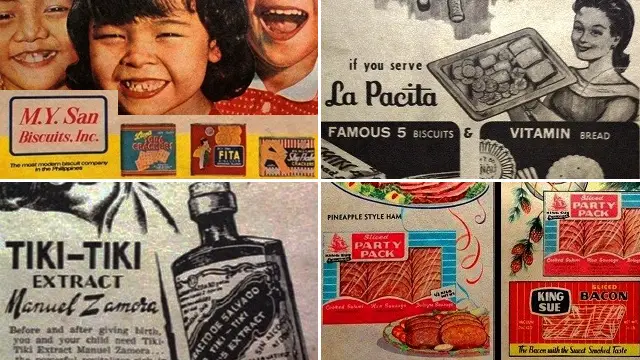
There’s a history behind everything, and this is especially true for Philippine brands and products we’ve grown to love over the years. Filipinos know them only by their brand names, oblivious to the fact that coming up with such names took creativity, serendipity, or both.
For the third time, let’s rediscover some of the most fascinating “behind-the-scenes” stories that gave birth to well-loved classic Filipino brands.
Also Read: 13 Amazing True Stories Behind Classic Filipino Brand Names
1. Tiki-Tiki (1909).
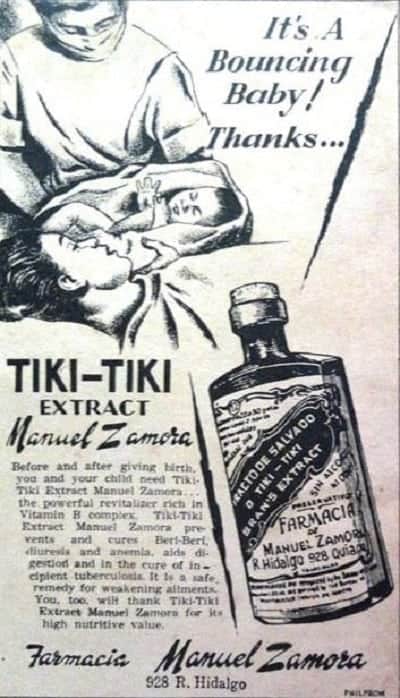
The discoverer of the vitamin formula that prevented infantile beri-beri was Sta. Cruz-born Manuel Zamora (1870 – 1929), a chemist-pharmacist who produced a stable version in 1909.
The result is a liquid vitamin supplement known today as Tiki-tiki. It is so named because it was made from “tikitiki” extract, which is the local term for rice bran, the byproduct of the milling that includes the seed coat and grain fragments. The extract is an excellent source of Vitamin B1, now known as thiamine, and has a higher amount of protein than polished rice.
Also Read: The Filipino Doctor Who Helped Discover Erythromycin (But Never Got Paid For It)
During the American colonial period, “tikitiki” is credited with saving thousands of Filipino babies from the dreaded beri-beri, after the Bureau of Science in the Philippines ordered its production. It is said that pharmaceutical giant Parke Davis made Zamora an offer to buy the rights to “tikitiki,” but he refused.
Today, tikitiki is produced by Unilab, under different brand names (United American Tiki-Tiki, Tiki-Tiki Star, Drop and Syrups).
2. Purico (1919).
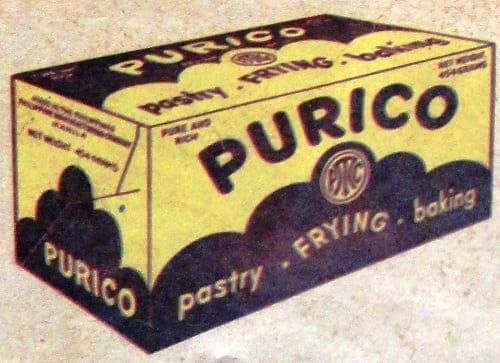
The Philippine Manufacturing Co. is largely the history of modern vegetable shortening in the country.
In 1917, it employed a chemist whose assignment was to start production of shortening and other edible products. Near the end of 1919, the first-ever vegetable shortening manufactured in the Philippines was launched. It was noted for its purity and richness that it was named PURICO—a term coined from combined words “puro” (pure) and “rico” (rich), as Spanish was still widely spoken then.
These qualities were underscored in slogans and headlines like “Always Pure. Always Rich,” and “So pure..so rich..Purico cooks more!”
Also Read: 13 Beloved Pinoy Products That Are No Longer Available
PURICO was sold in carton blocks with the familiar yellow label. The widely advertised PURICO (sponsor of the hugely popular radio show “Purico Amateur Hour,” later renamed “Tawag ng Tanghalan”) became a staple in all Filipino households, and could even be bought in portions from sari-sari stores.
The rise of liquid cooking oils eased out PURICO from the store shelves by the 1970s.
3. RAMCAR (1919).
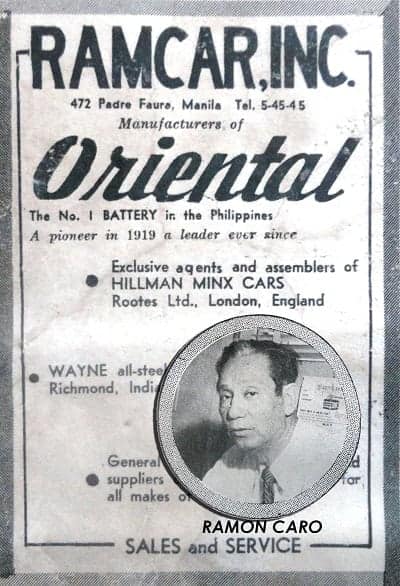
The pioneer battery, tire, and automotive service shop were founded in 1919 by Don Ramon Caro. RAMCAR is a combination of the first syllable of his first name and surname.
His first job was as an apprentice mechanic in several firms until he thought himself good enough to start RAMCAR. He was the manufacturer of the no. 1 batteries in the Philippines—the Oriental brand–as well as the first to assemble bantam cars (Hillman Minx) in the Philippines.
Ramon’s company also introduced innovations like encasing batteries in plastic, and the “Balik-Baterya” trade-in battery program. In 1997, RAMCAR merged with C.C. Unson Corporation to form Oriental and Motolite Corporation. The group has manufacturing and distribution facilities in the U.S. and a nationwide distribution facility in Australia.
4. La Pacita Biscuits (1921).
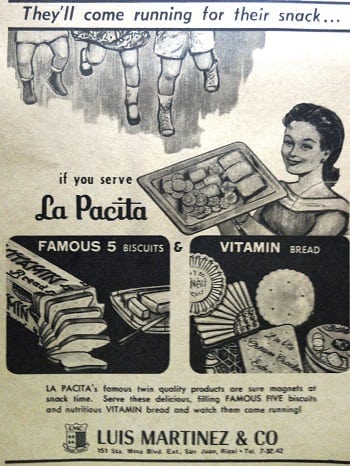
The Fabrica de Biscochos Y Dulces Biscuits Especiales was established in 1921 by Luis Martinez at Progreso St. (now J. Eustaquio) in San Juan. From this bakery came the very popular La Pacita brand of assorted biscuits, which was named after his wife Pacita.
Luis Martinez & Co. produced 5 kinds of La Pacita biscuits that included Cream Filled Cookies, Club Crackers, Chees-Et, Tostados (Prima) and Camachile (baby finger cookies), which became favorite in-between meal snacks, pasalubong treats and baon for schools and offices. L. Martinez and Co. also produced Vitamin Bread.
Also Read: Famous Filipino Brands With Surprising Origins
La Pacita Biscuits were heavily advertised in the 50s and 60s. In 1970, son Felicisimo took over the management and the company was rechristened F. Martinez and Co., Inc. The product line expanded with the addition of Pacensia, Butter Cookies, Raisin Cookies, and new product launches for Snax and Supreme Flakes.
The 90-year-old company was acquired by San Miguel-Purefoods in 2014.
5. King Sue Ham (1930).
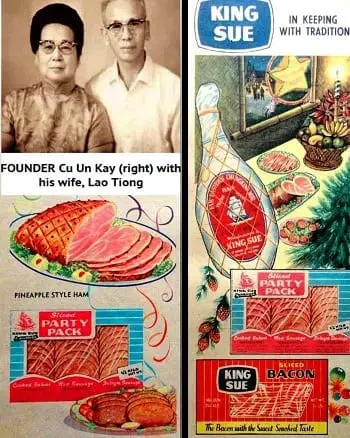
The ham and meat products that have come to be associated with festive celebrations for the past 85 years all bear the KING SUE name. The brand name comes from “King,” the family founder’s surname and “Sue,” pronounced Su-weh, the Fookienese word for “small.”
When Fookien native Cu Un Kay went to Manila to look for a cold storage facility for a possible ham business, he met a German national who taught him how to cure hams and other deli products. Cu thus began looking for ways to improve his products—his traditional bone-in Chinese ham product, for example, was cooked only in aluminum ware and 3 adobe stones.
Also Read: Thousands in China are descendants of an ancient Filipino king. Here’s how it happened.
King Sue products—from sausages, bacon, cold cuts to sweet hams—were specially prepared at King Sue Ham and Sausage Factory in Caloocan. They were heavily advertised in weekend magazines beginning in the early 1960s. Today, King Sue has even Filipino favorites like corned beef, tocino, and sisig.
6. Radiowealth (1930).
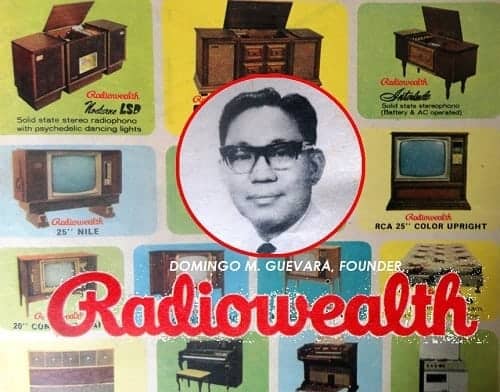
In 1930, a hardworking man from Camarines Sur—Domingo M. Guevara—started a radio repair shop, and as his small business gained ground, added radio dealership to his services.
Five years later, Guevara incorporated his profitable business and named it after the product responsible for his earned fortune—Radiowealth. He began importing radio sets and embarked on radio assembly in 1951. In 1955, Radiowealth went into local TV manufacturing, complete with beautiful wooden cabinetry, eventually including stereo consoles with fancy names such as Nocturne, Interlude and Claire de Lune, that became bestsellers. In 1966, it offered dealerships and franchising.
Even as Radiowealth forayed into selling air conditioners, refrigerators and electrical parts, its hallmark products remained to be its radios, stereos, and TV sets, constantly creating innovations like bubble screen TVs, and modular solid state stereos. Radiowealth enjoyed strong business through the 70s, but with the coming of compact digital technology in the 80s, interest in radios, large stereos, and bulky TVs waned.
Also Read: 13 Nostalgic Pinoy Kid-Oriented TV Shows That Defined Our Childhood
But the Guevaras had wisely diversified its businesses by then, with its Guevent Investment Corp., a multi-billion peso company that had interests and investments in real estate, finance, transportation, I. T. and telecoms, medical and hospitality services, among others. The legacy of the Radiowealth name is preserved in its subsidiary, Radiowealth Finance Co. Inc.
7. M.Y. San Biscuits (1935).
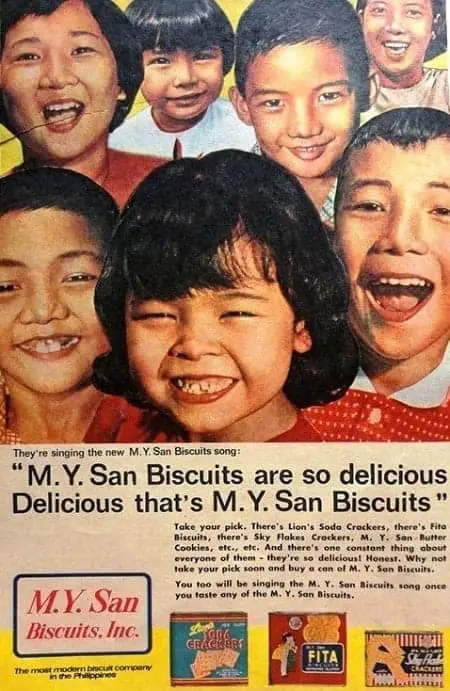
In 1935, a group of enterprising Chinese brothers took over the Escolta Ice Cream Parlor, turned it into a restaurant and started serving baked crackers, biscuits and cookies, along with the regular snack fare. These turned out to be popular items in the menu.
Mar Yu San led his brothers in running the business until the restaurant gave way to the construction of the Crystal Arcade. The Mar family, however, continued to produce an assortment of wholesome biscuits that would be incorporated into a company called M.Y. SAN Biscuits, Inc., after the enterprising Mar Yu San.
Also Read: Top 10 Favorite Snacks that Bring Back Our Childhood
M.Y. San ’s early products became instant favorites—Lion Soda Crackers, Fita, Skyflakes, Butter Cookies, and Graham Crackers. By the 1980s, it was the most modern biscuit factory in the Philippines. In 2001, Nissin Monde, the food company known for producing Lucky Me Noodles, acquired the biscuit pioneer, to become Monde M.Y. SAN Corporation.
8. LVN Pictures, Inc. (1938).
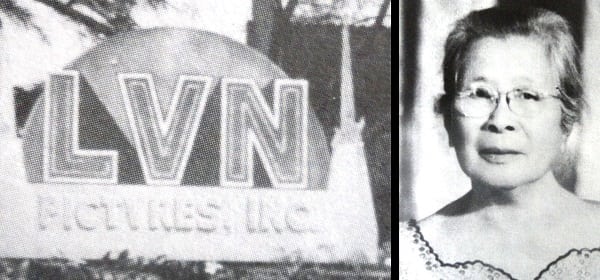
LVN Pictures Inc. is known as the Philippines’ Metro-Goldwin-Mayer (MGM) for being a premiere studio with the biggest stars under its contract. It was established way back in 1938, and the founding partners led by Dña. Narcisa de Leon, Carmen Villongco and Eleuterio Navoa Sr. gave the first letters of their surnames to the biggest film studios in the Philippines—hence, L-V-N.
At its peak, LVN became a worthy rival to Sampaguita Pictures. The studios occupied a large parcel of land straddling P. Tuazon Boulevard, C. Benitez and St. Peter Street in Cubao. The LVN Gate, with the initials of the studio, became a landmark in the area.
In July of 1939, LVN released its first offering, the movie musical “Giliw Ko,” (starring Fernando Poe Sr., Ely Ramos and Mona Lisa), which became a blockbuster hit that year. It also launched the first Filipino color film in 1941, “Ibong Adarna.”
Its stable of stars included Rogelio and Jaime de la Rosa, Mila del Sol, Norma Blancaflor, Lilia Dizon, and Rosa Rosal, among others. In 1961, LVN ceased film production and shifted to offering post-production services up until 2005. The expansive LVN lot is now being developed into a condominium.
9. Bob’s Studio (1946).
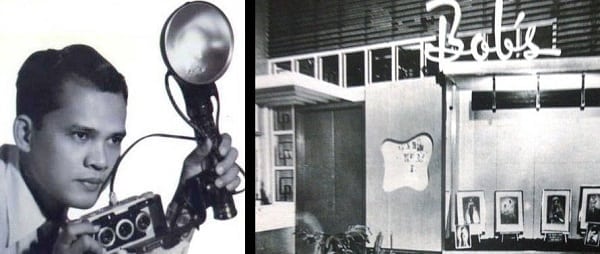
If you’ve come across glamorous portraits of alta-sociedad personalities, chances are they were taken by the country’s premiere studio, BOB’S Manila. It was derived from the name of the founder, now hailed as the dean of salon photography, Pablo Razon (1913 – 2013) of Pampanga.
His nickname was actually “Pabs,” but American clients would often mispronounce it and call him Bob instead. So, in 1946, when it was time to rebuild his business, he chose a spot along Rizal Avenue near the Manila Grand Opera House and named it BOB’S Manila.
Word got around of the classy portraits he was making and soon, his services were being sought after by prominent Filipinos. His client list reads like a who’s who of Philippine crème de la creme—Quirino, Roxas, Magsaysay, Garcia, Marcos, Ramos, Aquino-Cojuangco, Concepcion, Araneta, Oppen.
Also Read: 00 Years of Filipino Men And Women’s Beauty Captured In Vintage Photographs
National queens Gemma Cruz, Cristina Matias, Cynthia Ugalde and Edita Vital had their sittings at BOB’s, and his photos of stars like Rosa del Rosario, Rogelio de la Rosa and Leopoldo Salcedo appeared on magazine covers. Bob also married one of his models, “Covergirl” winner, Virginia Warne.
Bob Razon’s heirs have kept his business going at their M. Adriatico office-residence after his death.
10. Cartimar Market (1956).
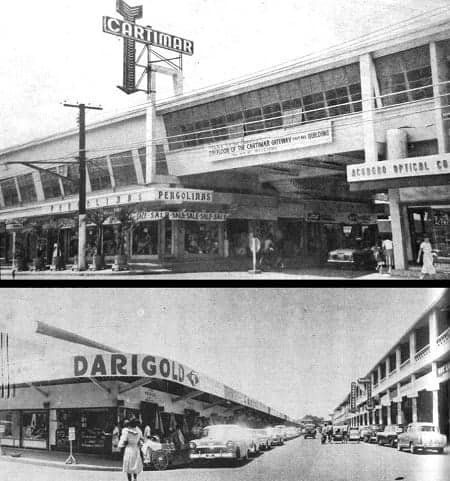
In 1956, Cartimar Market in Pasay opened to wide acclaim and was hailed as the city’s most modern and best-laid out shopping center. Owned by the prominent Oppens, it was managed by Ernesto Oppen at the time of its inauguration.
Cartimar was derived from the combination of the first syllable of his parents-in-law, CARlos Cuyugan and wife, TImotea Lichauco, and only daughter, MARgarita, whom Ernesto wed in 1937.
Sitting on 2.5 hectares of land bounded by Taft Avenue in front and Leveriza St. at the back, Cartimar boasted of parking spaces along the wide Cartimar Avenue, which spanned 12 meters. It had 8 buildings which housed over 1,000 stalls.
Also Read: 29 Things You’ll Never See in Manila Again
Cartimar became a shopping haven in the 60s, frequented by wealthy Makati people for fresh fish and produce. One could go in their Sunday’s best to shop for footwear, novelties and the latest fashion trends.
In the 70s-80s, it was Manila’s coolest place to find imported PX goods, and the go-to place for bicycles and pets in the 90s. By then, Greenhills and Greenbelt had already established themselves as more superior shopping places.
For sentimental reasons, Cartimar has loyal customers who continue to patronize what a 1955 magazine once described as “the best-looking shopping market where one can shop leisurely, conveniently…and in style.”
11. Lawanit (1957).
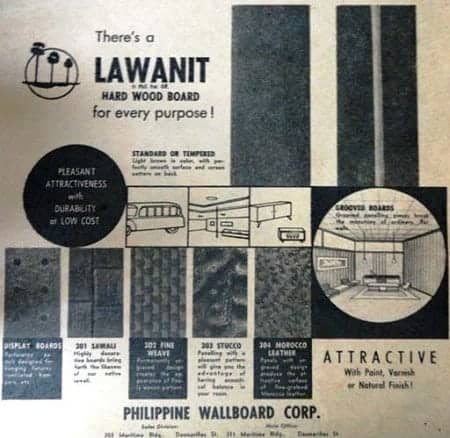
The revolutionary pressed board known for its affordability, versatility, and durability was introduced to the Philippine market in 1957 by the Philippine Wallboard Corporation, from its factory in Nasipit, Agusan del Norte.
It was called Lawanit, as its main component was the wood pulp of the lawan tree, also known as “meranti” in other Southeast Asian countries. Lawan pulp was mixed with shredded wood and other cellulose type materials and compressed to form boards used for paneling, ceilings, walls, and other construction purposes.
Before lawanit, plywood—made of bonded layers of wood—was the favored wooden material. Lawanit changed all that because it was cheaper, stable and easily paintable. To demonstrate the utility of the product, a “Lawanit House” was built by the company to promote its products.
Also Read: 3 Pinoy Expressions With Crazy Origins You Would Never Have Guessed
Lawanit was soon being used in the construction of modern mid-century houses, favored over the more expensive plywood which tended to peel over time. Today, Lawanit has become a generic term for pressed boards that have different wood-based ingredients like coconut fiber.
12. CDO Meat Products (1975).
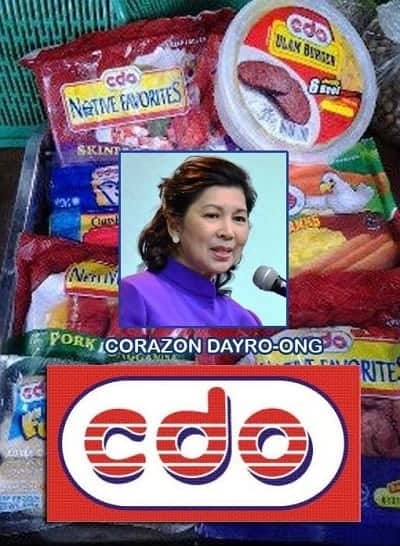
One of the leading Filipino meat processing companies, CDO began in June of 1975 as a small, backyard business of housewife Corazon Dayro-Ong.
She introduced the idea of serving home-made skinless longganisa to her family. When her friends started placing orders for them, Ong decided to venture into longganisa-making in her Valenzuela home, using a Php 60,000 bank loan. It was the start of an enterprise that would grow into a giant corporation producing tocino, sausages, hams, bacon, tuna, hamburger patties, loaves, and sweet preserve, marketed and sold under the brand “CDO,” the founder’s initials.
In 1981, Foodsphere Inc. was registered and the company became CDO–Foodsphere Inc. CDO was retained as the flagship name of its food products.
The company recovered from a fire that gutted the processing plant and was back on its feet in 1990. The first CDO TV ad broke in 1995, generating attention and sales, and making the CDO name known nationwide. The company introduced innovations with the Spanish-inspired dish called “carne norte’” and San Marino corned tuna, which today are Filipino favorites.
13. Julie’s Bake Shop (1981).
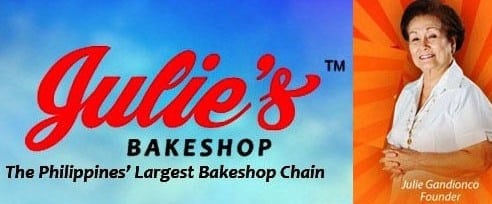
The country’s largest bakeshop chain was founded in Cebu by an intrepid housewife who was not even a baking enthusiast!
On January 6, 1981, Mrs. Julia Gandionco, already an operator of 3 canteens, ventured yet into another business—a bakeshop. Her eldest son Bobby convinced the modest Julie to name her bakeshop after herself, and so, Julie’s Bake Shop was on its way.
Also Read: Halo-Halo: The Surprising Origin of Philippines’ Beloved Dessert
Her bread products—baked in full view of customers–were warmly received and widely patronized. Just half a year after opening her first shop, she opened a second store, which then became ten in 3 years.
Franchising allowed the business to expand nationwide, beginning in 1998, boosting the number of branches to 210 by 1999. Today, Julie’s Bake Shop continues to serve and improve classic baked goodies as well as offer new bread varieties.
14. Ever Bilena (1983).

From a single proprietorship business selling nail polish in 1983, Ever Bilena has grown into a nationwide business with a full cosmetic line, thanks to the visionary founder, Dioceldo Sy.
Ever Bilena is a combination of English and Chinese words. “Bile” is the Chinese term for ‘beautiful’ and “Na” means ‘lady.’ Ever Bilena, thus, means “ever beautiful lady.”
By 1985, the brand has grown into a full cosmetic line (more than 1,000 products), with over 200 beauty consultants in its department store outlets. Along with its business success, Ever Bilena became a household name with beauty products known for quality and affordability.
About the Author: Alex R. Castro is a retired advertising executive and is now a consultant and museum curator of the Center for Kapampangan Studies of Holy Angel University, Angeles City. He is the author of 2 local history books: “Scenes from a Bordertown & Other Views” and “Aro, Katimyas Da! A Memory Album of Titled Kapampangan Beauties 1908-2012”, a National Book Award finalist. He is a 2014 Most Outstanding Kapampangan Awardee in the field of Arts. For comments on this article, contact him at [email protected]
Selected References
Bob Razon: A Life Devoted to the Salon Style. (1999) (pp. 18-21).
Concepcion, J. (2015). Go Negosyo’s inspiring Filipina entrepreneurs. philSTAR.com. Retrieved 15 September 2016, from https://goo.gl/I2a3CZ
Did you know: Manuel A. Zamora and the ‘tiki-tiki’ formula. (2014). Inquirer.net. Retrieved 15 September 2016, from https://goo.gl/autcfE
Mercado, M. (1977). Doña Sisang and Filipino Movie. A. R. Mercado Management.
Philippine Daily Inquirer,. (2015). King Sue Marks 85th Year.
Progress Report on Philippine Business and Industry, Volume II. (1961).
Radiowealth advertorial. (1970). The Sunday Times Magazine.
Tableau: Encyclopedia of Distinguished Personalities in the Philippines. (1957) (p. 113).
FilipiKnow
FilipiKnow strives to ensure each article published on this website is as accurate and reliable as possible. We invite you, our reader, to take part in our mission to provide free, high-quality information for every Juan. If you think this article needs improvement, or if you have suggestions on how we can better achieve our goals, let us know by sending a message to admin at filipiknow dot net
Copyright Notice
All materials contained on this site are protected by the Republic of the Philippines copyright law and may not be reproduced, distributed, transmitted, displayed, published, or broadcast without the prior written permission of filipiknow.net or in the case of third party materials, the owner of that content. You may not alter or remove any trademark, copyright, or other notice from copies of the content. Be warned that we have already reported and helped terminate several websites and YouTube channels for blatantly stealing our content. If you wish to use filipiknow.net content for commercial purposes, such as for content syndication, etc., please contact us at legal(at)filipiknow(dot)net